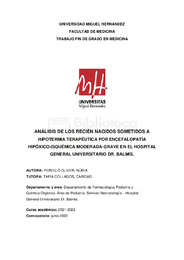Título :
Análisis de los recién nacidos sometidos a hipotermia terapéutica por encefalopatía hipóxido-isquémica moderada-grave en el hospital general universitario Dr. Balmis |
Autor :
Perelló Oliver, Núria |
Tutor:
Tapia Collados, Caridad  |
Editor :
Universidad Miguel Hernández de Elche |
Departamento:
Departamentos de la UMH::Farmacología, Pediatría y Química Orgánica |
Fecha de publicación:
2022-05-10 |
URI :
https://hdl.handle.net/11000/28569 |
Resumen :
Introducción: La Hipotermia Terapéutica (HT) ha demostrado ser un tratamiento eficaz y seguro para neonatos con encefalopatía hipóxico-isquémica(EHI) moderada o grave.
Objetivos: Analizar las características de los neonatos sometidos a HT como tratamiento para EHI moderada o grave, describir las características clínicas y demográficas de los pacientes sometidos a dicho tratamiento y conocer morbilidad asociada, mortalidad y evolución durante su ingreso hospitalario.
Métodos: Estudio descriptivo retrospectivo de los casos de EHI moderada o grave tratados con HT en el Hospital General Universitario Doctor Balmis (HGUA) desde mayo 2013 hasta diciembre 2021 a partir de la revisión de las historias clínicas electrónicas.
Resultados: Se incluyeron 68 pacientes, el 64,7% con EHI moderada y el resto con EHI grave. 78% procedían de otros hospitales. En un 94,12% de los casos se identificaron antecedentes obstétricos de riesgo. La temperatura media al ingreso fue de 33,9ºC. Al 100% se les realizó ecografía (ECO) cerebral y al 85,29% resonancia nuclear magnética (RMN) cerebral. Un 6,82% de RN con EHI moderada fallecieron y un 75% con EHI grave.
Conclusiones: La EHI es la principal causa de muerte y discapacidad, junto a la prematuridad, en el periodo neonatal. Actualmente solo la HT ha demostrado ser un tratamiento seguro y eficaz para los niños con EHI moderada o grave. Los datos analizados en el HGUA son similares a los referidos en la literatura. La
investigación sobre el desarrollo de nuevos tratamientos que, de manera aislada, o combinados con la HT, permitan mejorar los resultados obtenidos, debe continuar.
Introduction: Therapeutic Hypothermia (TH) has been shown to be an effective and safe treatment for neonates with moderate or severe hypoxic-ischemic encephalopathy (HIE).
Objectives: To analyse the characteristics of neonates subjected to TH as a treatment for moderate or severe HIE, to describe the clinical and demographic characteristics of the patients subjected to such treatment and to know associated morbidity, mortality and evolution during hospital admission.
Methods: Retrospective descriptive study of the cases of moderate or severe HIE treated with TH at the Hospital General Universitario Doctor Balmis (HGUA) from May 2013 to December 2021 based on the review of electronic medical records.
Results: 68 patients were included, 64.7% with moderate HIE and the rest with severe HIE. 78% came from other hospitals. In 94.12% of the cases, risky obstetric antecedents were identified. The mean temperature at admission was 33.9ºC. Brain ultrasound (ECHO) was performed in 100% of cases and brain magnetic resonance imaging (MRI) in 85.29%. 6.82% of newborns with moderate HIE died and 75% with severe HIE.
Conclusions: HIE is the leading cause of death and disability, along with prematurity, in the neonatal period. Currently, only TH has been shown to be a safe and effective treatment for children with moderate or severe HIE. The data analysed in the HGUA are similar to those reported in the literature. Research on the development of new treatments that, in isolation or in combination with TH, can improve the results obtained, should continue.
|
Palabras clave/Materias:
Hipotermia terapéutica
Recién nacidos
Neonatos
Encefalopatías
Encefalopatía hipóxico-isquémica |
Área de conocimiento :
CDU: Ciencias aplicadas: Medicina |
Tipo documento :
application/pdf |
Derechos de acceso:
info:eu-repo/semantics/openAccess |
Aparece en las colecciones:
TFG- Medicina
|
 La licencia se describe como: Atribución-NonComercial-NoDerivada 4.0 Internacional.
La licencia se describe como: Atribución-NonComercial-NoDerivada 4.0 Internacional.
.png)
